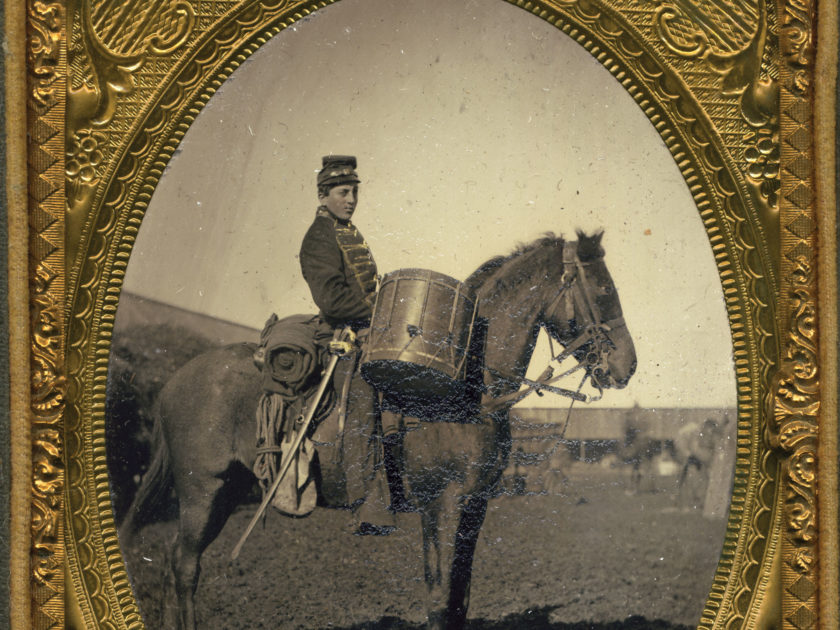A gallery of portraits of Civil War drummers collected in collaboration with Editor Dale Niesen of the Facebook group “The Image Collector” and contributions by collectors, reviewed by Contributing Editor Chris Nelson.

A HINT OF A SMILE is evident on the face of this Union drummer boy with an elaborate neck strap and full-size bass drum. The large shield patch with Roman numeral indicates his membership in the 10th Legion, a combined force of infantry, cavalry and artillery proposed by New York Representative Charles Van Wyck of the Empire State’s 10th Congressional District. The red tinting on the patch, cap and trim of his state-issued semi-chasseur jacket suggests he served in the artillery section, which later became the 7th and 8th New York Independent Batteries. It is also possible that the red trim indicated his membership in the infantry section, which mustered into federal service as the 56th New York.

A DRUMMER IN THE 8TH CALIFORNIA INFANTRY balances his drum with his thigh against the photographer’s column and strikes a confident pose with drumsticks in hand. He is John Herald, an 18-year-old peacetime jockey from Salem, Mass., who joined the regiment in early 1865 as a private. He became a drummer a couple months into his enlistment. Later that year, his mother, Mary, got wind that he had joined the army and she petitioned the government for his release for becoming a soldier without her consent. According to her letter, preserved in Herald’s military service record, his real name was John W. Griffin, and he was only 17. The regiment’s term expired before authorities acted on Mary’s request. Griffin, alias Herald, spent the rest of his life in the West, dying in Los Angeles in 1921 at age 73. His obituary paid tribute to his role as a California pioneer, but did not mention his military service.

THIS DRUMMER props a foot on the edge and head of his drum and balances sticks on his thigh. His uniform and kit suggest he had money to spare. His 9-button, non-regulation short jacket is well tailored. The drumsticks are topped with silver. The drum is exquisitely detailed with a custom painted eagle, shield and rays, fancy hoop trim, fine tension ropes and stars on the leather tighteners. Upon the drumhead sits the young man’s cap with a two-digit regimental number barely visible along the base of the crown. He may have served in one of three regiments identified with the photographer’s location in Lowell, Mass: the 28th, 30th or 33rd infantries.
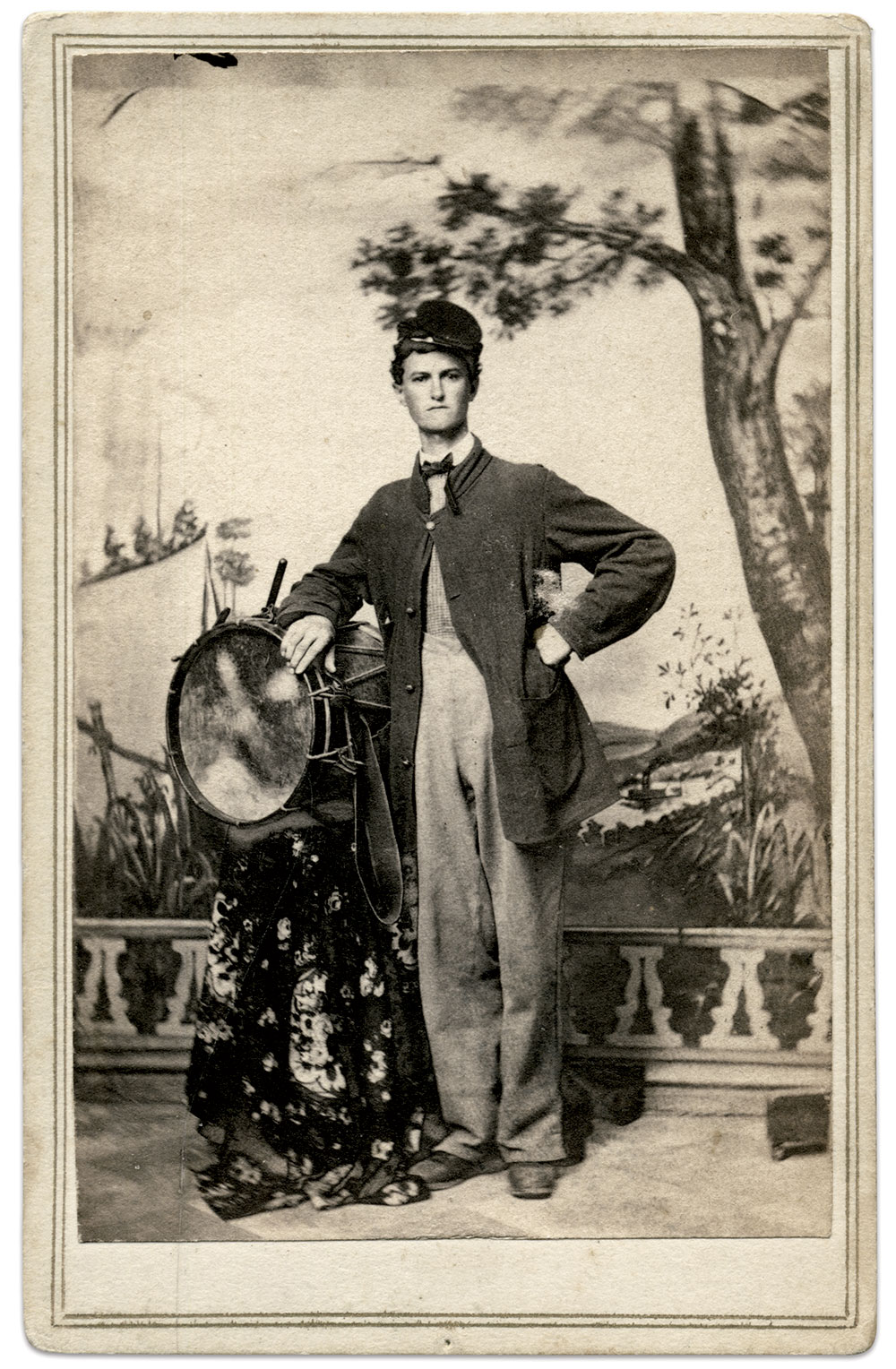
THE MUSICIAN’S KIT—drum, sling and sticks—sit atop a table in this photographer’s studio with a patio scene painted on a backdrop. The clean-shaven man posed with it is Ohio-born drummer Thomas C. Hatfield, who served in the Buckeye State’s 79th Infantry. The regiment participated in the Atlanta and Carolinas Campaigns. Hatfield survived his enlistment, but his life was cut short at age 42 in 1885 by consumption.
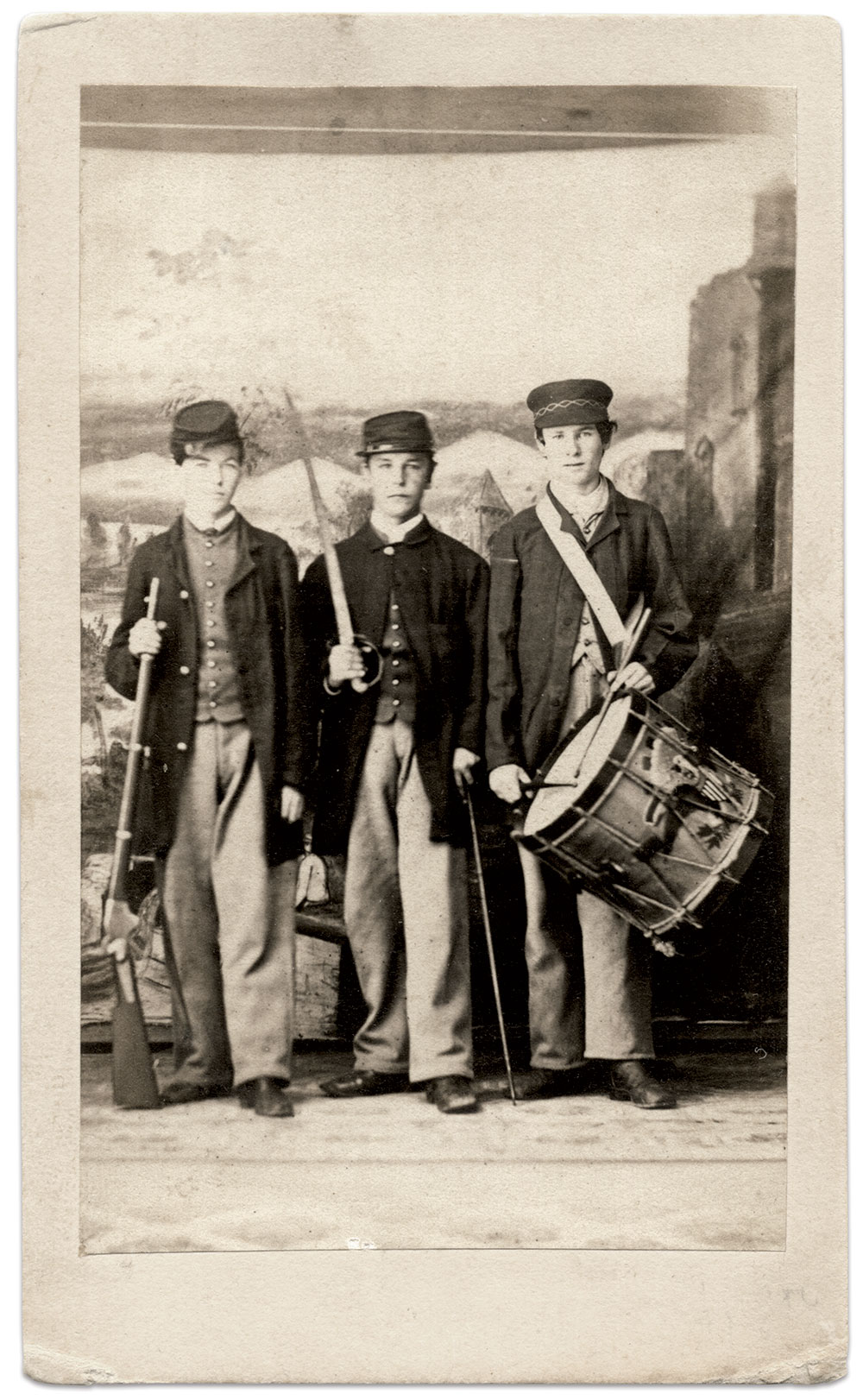
THIS REGULATION PAINTED DRUM and fabric shoulder sling is carried by a young man wearing a civilian cap. His pards, dressed in 4-button sack coats, are armed with a Spencer rifle and officer’s sword. Such weapons are not common to infantry privates, and may have been provided to them for this shot. The backdrop, featuring what appears to be a castle with turrets, offers a clue to identity and location of this photographer.


A CAVALRY DRUMMER sits on his mount equipped with full gear. Visible in the background are outbuildings and a slope that might be a roofline or perhaps a fort’s parapet.

THE IMAGE OF THE EAGLE AND SHIELD on this Union infantry snare drum is especially clear due to the lack of color tinting and the placement of the tension ropes. The musician sits in front of the well-known backdrop used by photographer Enoch Long at Benton Barracks in St. Louis.
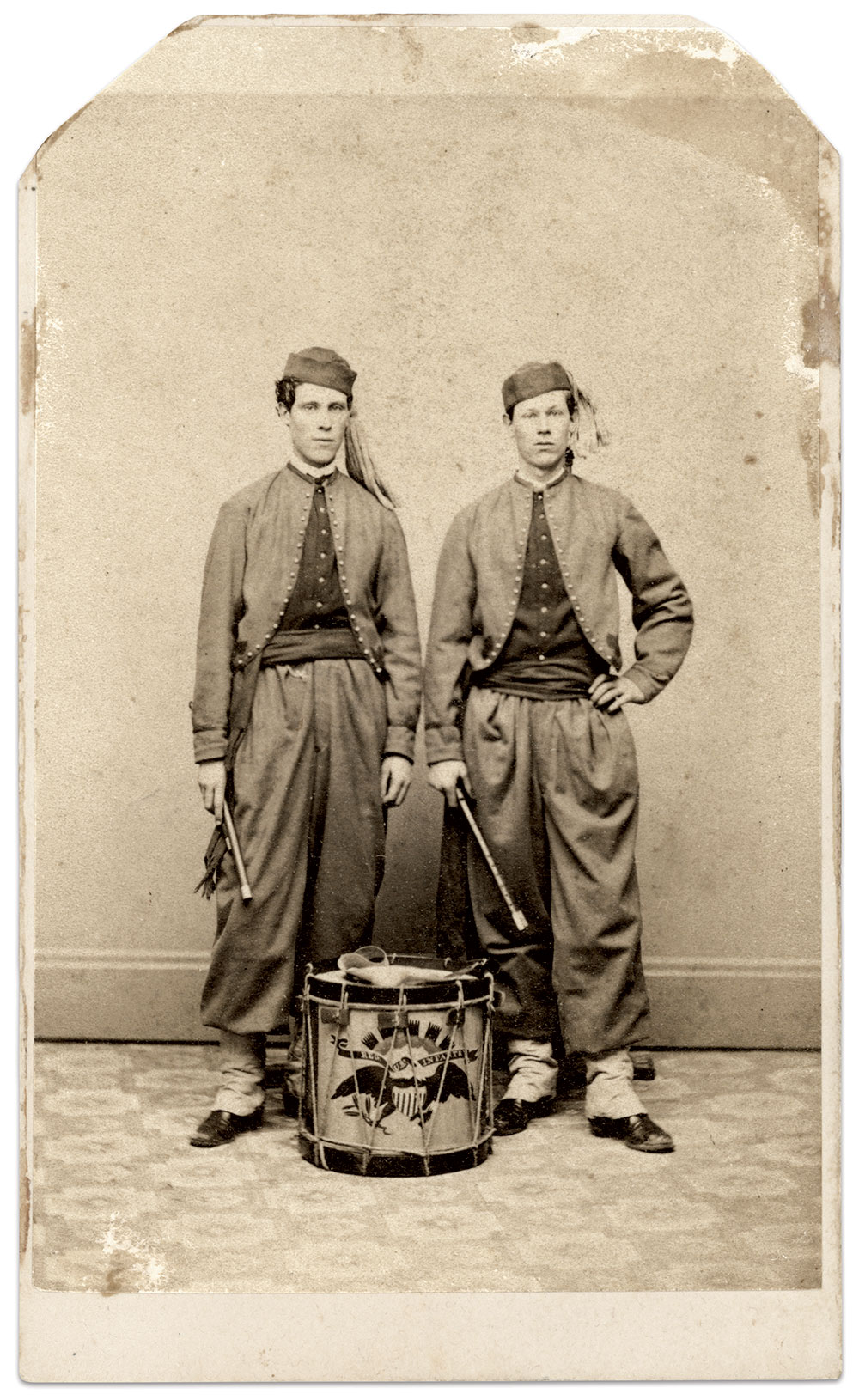
TWO ZOUAVES from an unidentified unit stand with fifes in hand and a regulation drum and sling at their feet. The man on the left holds a drumstick tucked below his fife.
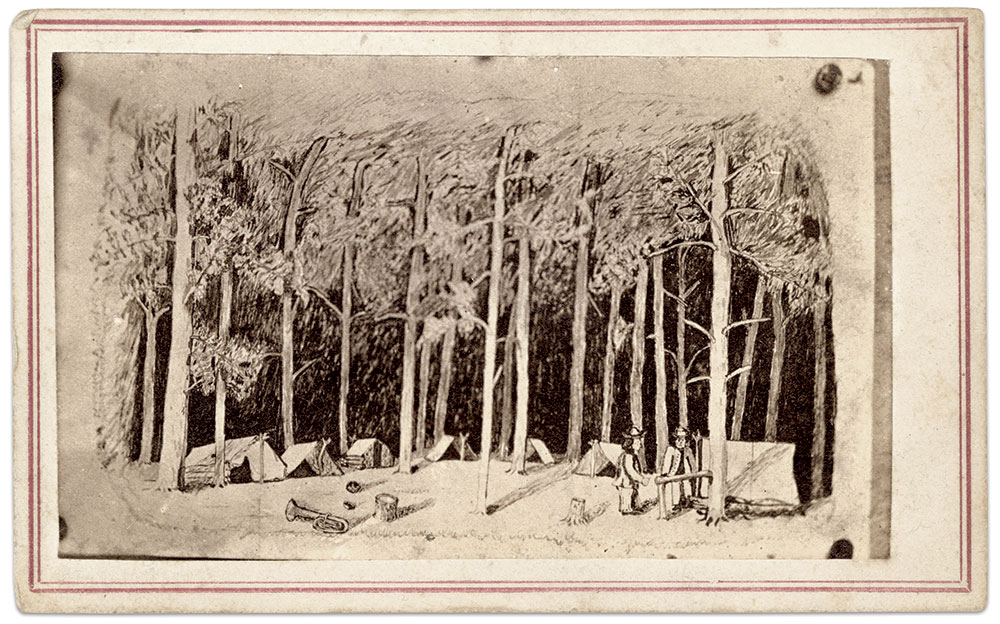
AN UNIDENTIFIED ARTIST’S PRIMITIVE SKETCH of tents arranged in a semicircle beneath a forest canopy includes a drum and horns in the foreground. Several of the tents are constructed upon log foundations, indicating these were semi-permanent quarters. Two soldiers, likely musicians, stand off to the side. A note on the back, in period ink, identifies the scene as the camp of the Third Brigade Band near Middletown, Va. The Third Brigade served with the First Division of the Sixth Army Corps. A hand-cancelled revenue stamp on the back of the mount dates the print between August 1864 and August 1866.
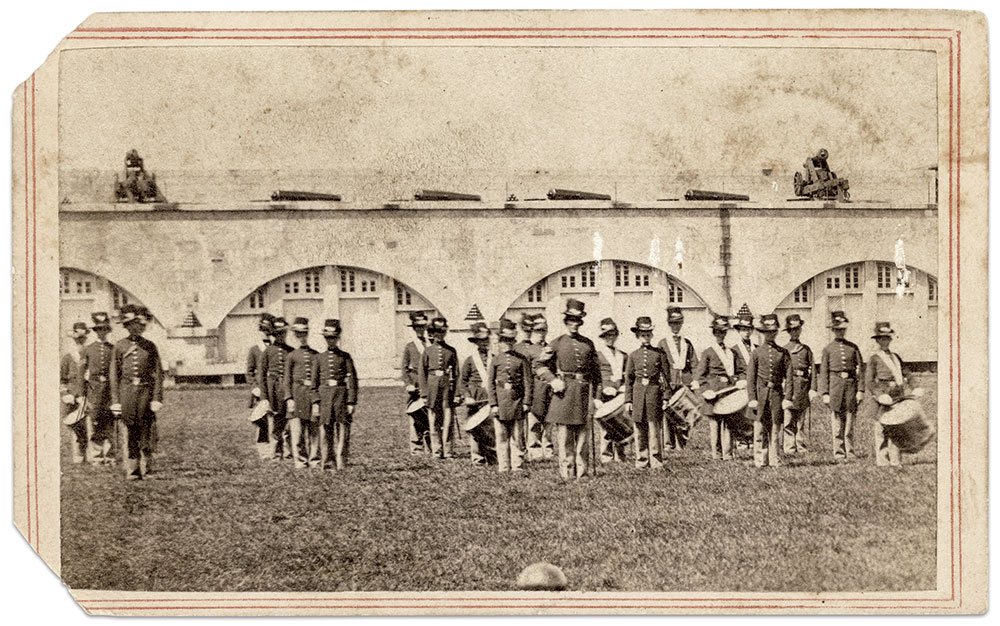
FORT ADAMS occupies an important place in the history of the 15th U.S. Infantry. In 1862, the coastal fortification adjacent to Newport, R.I., became its headquarters and recruitment station. About 1863 or 1864, the regiment’s band posed for this portrait against a backdrop of one of the fort’s walls with mounted and unmounted cannon on the parapet. Following the bombardment of Fort Sumter in 1861, fears for the safety of the U.S. Naval Academy in Annapolis, Md., prompted its removal to Rhode Island for the duration of the war. Academy faculty and cadets occupied Fort Adams for a few months in 1861 before moving to a hotel in Newport. The Union commander of Fort Sumter’s garrison in 1861, Robert Anderson, commanded Fort Adams for a few months in 1863.

A PAIR OF DRUMSTICKS appears to be freestanding and perfectly balanced against the body of this drum. The tops can be seen against the contrasting drumhead. The effect is the result of the sticks being tucked behind the drum’s tension ropes. A principal musician wearing non-standard chevrons and a trimmed cap, he served in the 8th Michigan Infantry. His identity is currently unknown.
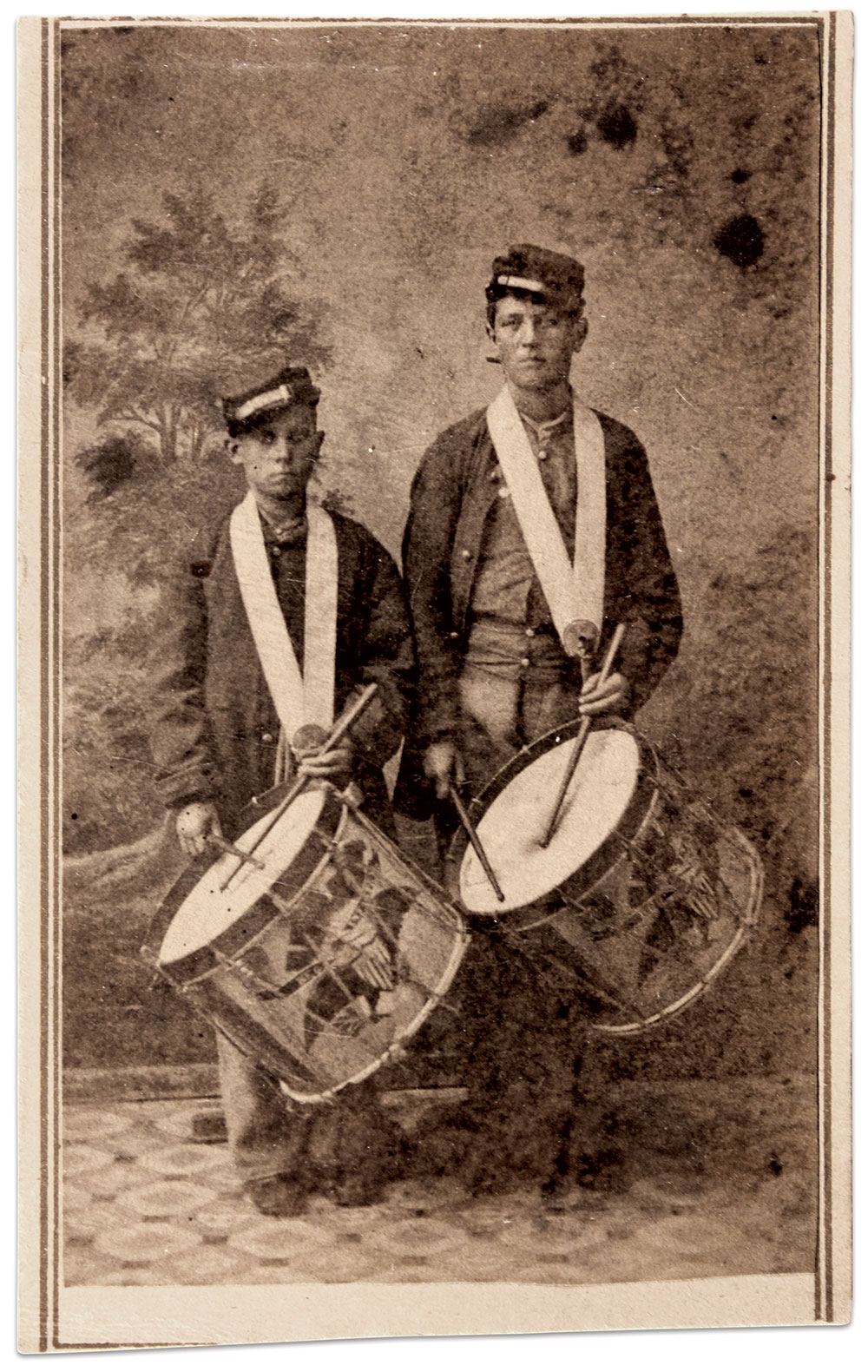
EQUIPPED WITH MATCHING DRUMS, slings, sack coats and caps, these boys are posed in front of a painted backdrop of an idyllic woodland scene.
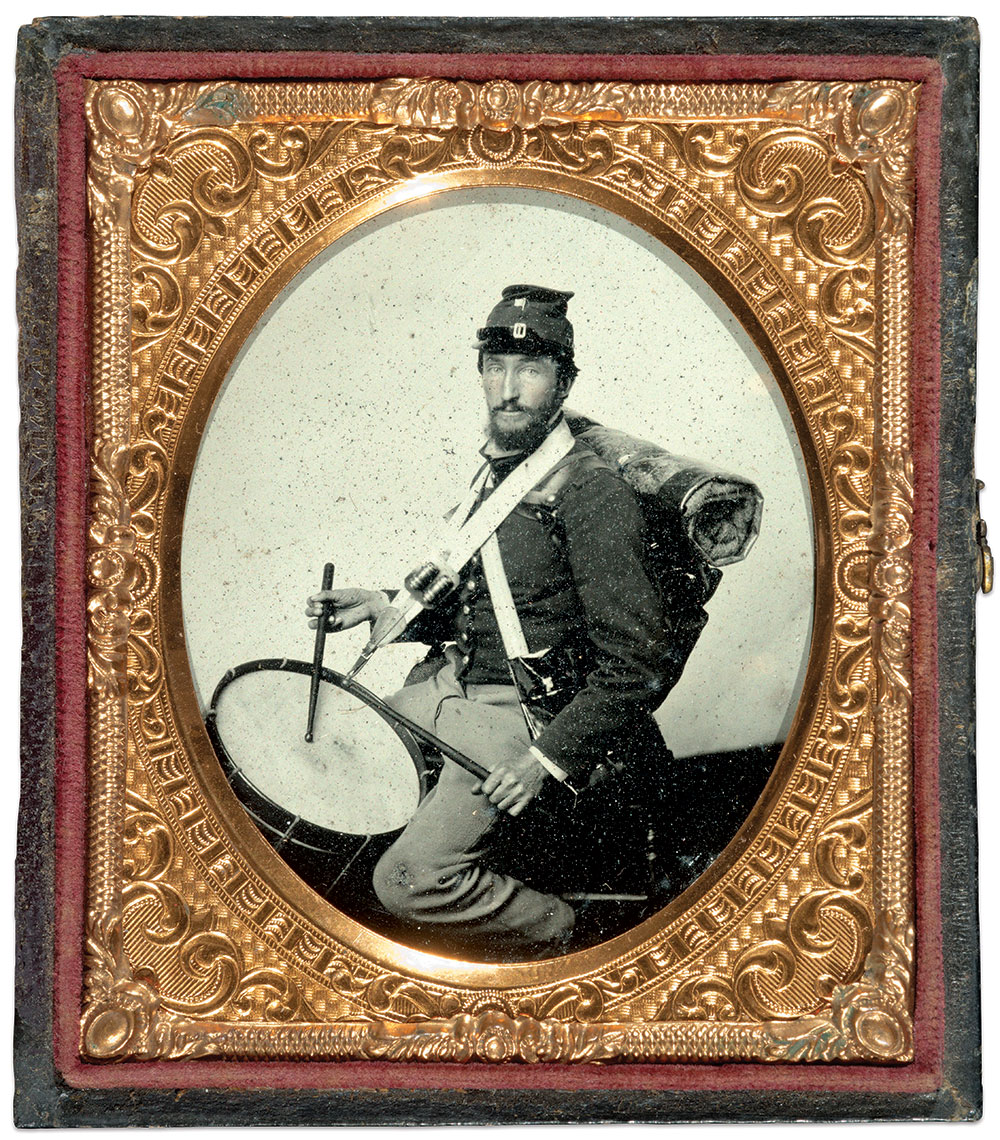
TUESDAY, OCT. 1, 1861, proved especially memorable for Hamilton Wallace Glezen. On that day, he volunteered to fight for the Union and proposed marriage to his sweetheart, Sarah Rose.
A whirlwind of activity followed for Glezen, 35, a physician in Petersburg, Ind., who had landed in the Hoosier State by way of his native Pennsylvania and gold-seeking in California. He attended to his patients, asked permission to wed Sarah from her parents, and made wedding arrangements. In the midst of the hustle and bustle, Glezen found time to listen to a patriotic speech by a Union officer. Glezen exclaimed in his journal, “My lady love was there & I was glad I had volunteered. After the speech I proposed a thousand cheers for the stars and stripes.”
Life was grand. Two days after Glezen proposed, he and Sarah married. A week later, Glezen bid his newlywed wife goodbye with tears of joy, and set off on another grand adventure as a drummer in the 58th Indiana Infantry.
His army journey ended less than a year later when he received a discharge, probably to care for Sarah, who had fallen ill. She died in 1863 at about age 27. Glezen joined her in death six years later—but not before he had remarried Sarah’s younger sister, Melona. She raised their two daughters, Hattie and Alice, as a single parent, and never remarried before her death in 1930.
—Research by Kraig McNutt

A DRUMMER BOY AND FIFER pose with their instruments in front of a plain canvas backdrop. Their 5-button sack coats with piped stand-up collars and no cuff decoration are consistent with those worn by Wisconsin volunteers. This information, combined with the number painted in gold upon their caps, suggests they served in the 16th Wisconsin Infantry. Organized in 1861, the hard-fighting regiment participated in the Battle of Shiloh, the Siege of Vicksburg, the Atlanta and Carolinas campaigns, and the March to the Sea. Their age difference suggests they may have been father and son, brothers or simply pards. Their fates in the war are not currently known.

AN ALBUM connected to Monroe, Mich., and the 18th Infantry includes this carte of a drummer boy dressed in a 9-button jacket and civilian cap. He carries his drum with a thin shoulder strap. The tension ropes on the drum are held in place with leather tighteners, one of which protrudes from the side of the unadorned, cylindrical body.
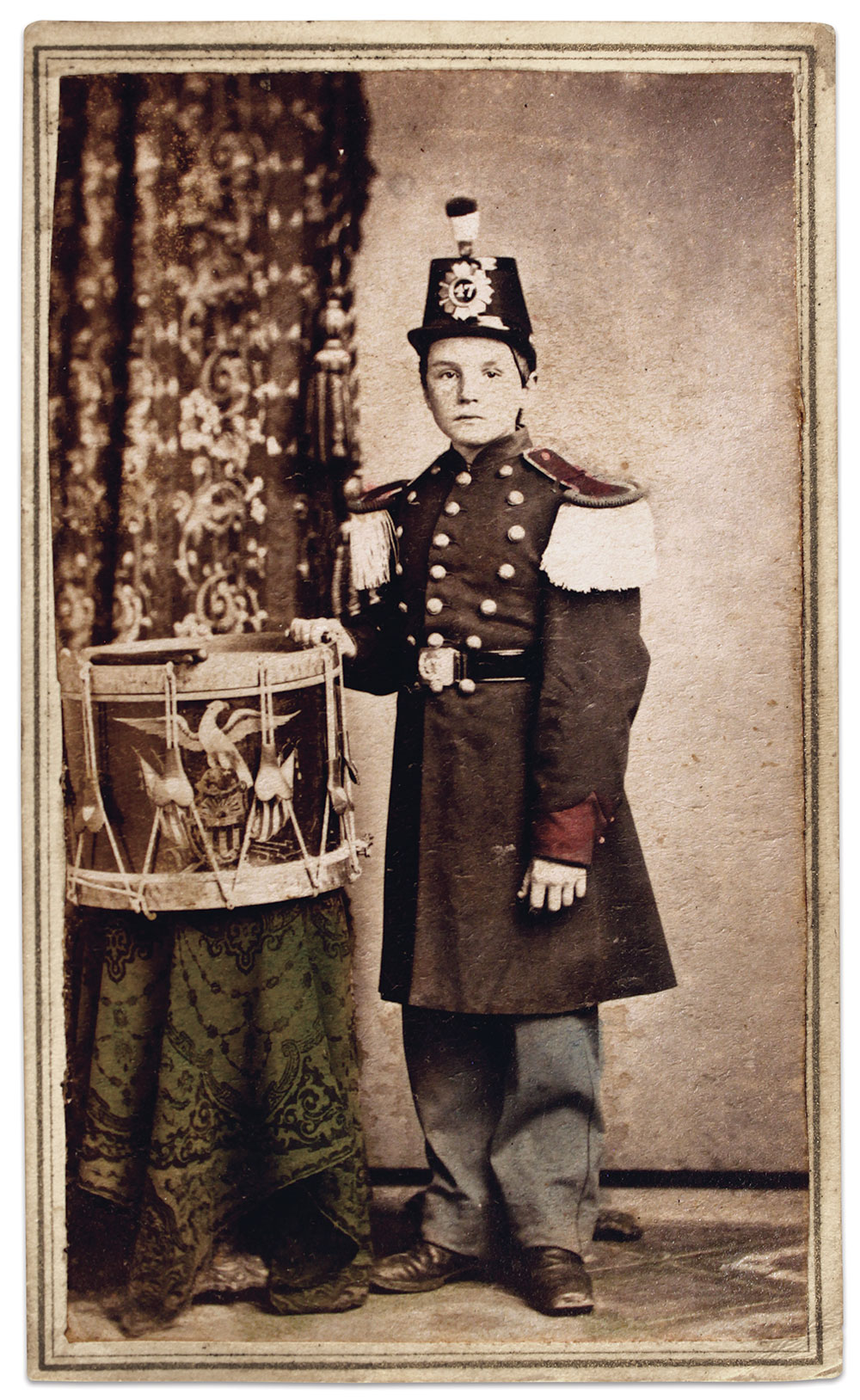
A MUSICIAN IN NEW YORK’S 47TH STATE MILITIA, dressed in a red-trimmed uniform complete with epaulettes and a shako emblazoned with the regimental number, poses with his drum. Note the distinctive eagle and shield motif painted on the side and the leather tighteners decorated with Union shields. It is not known if this drummer participated in two federal activations: A three-month stint in mid-1862 at Fort McHenry in Baltimore, Md., and a month-long call in the defenses of Washington, D.C., during the 1863 Gettysburg Campaign.
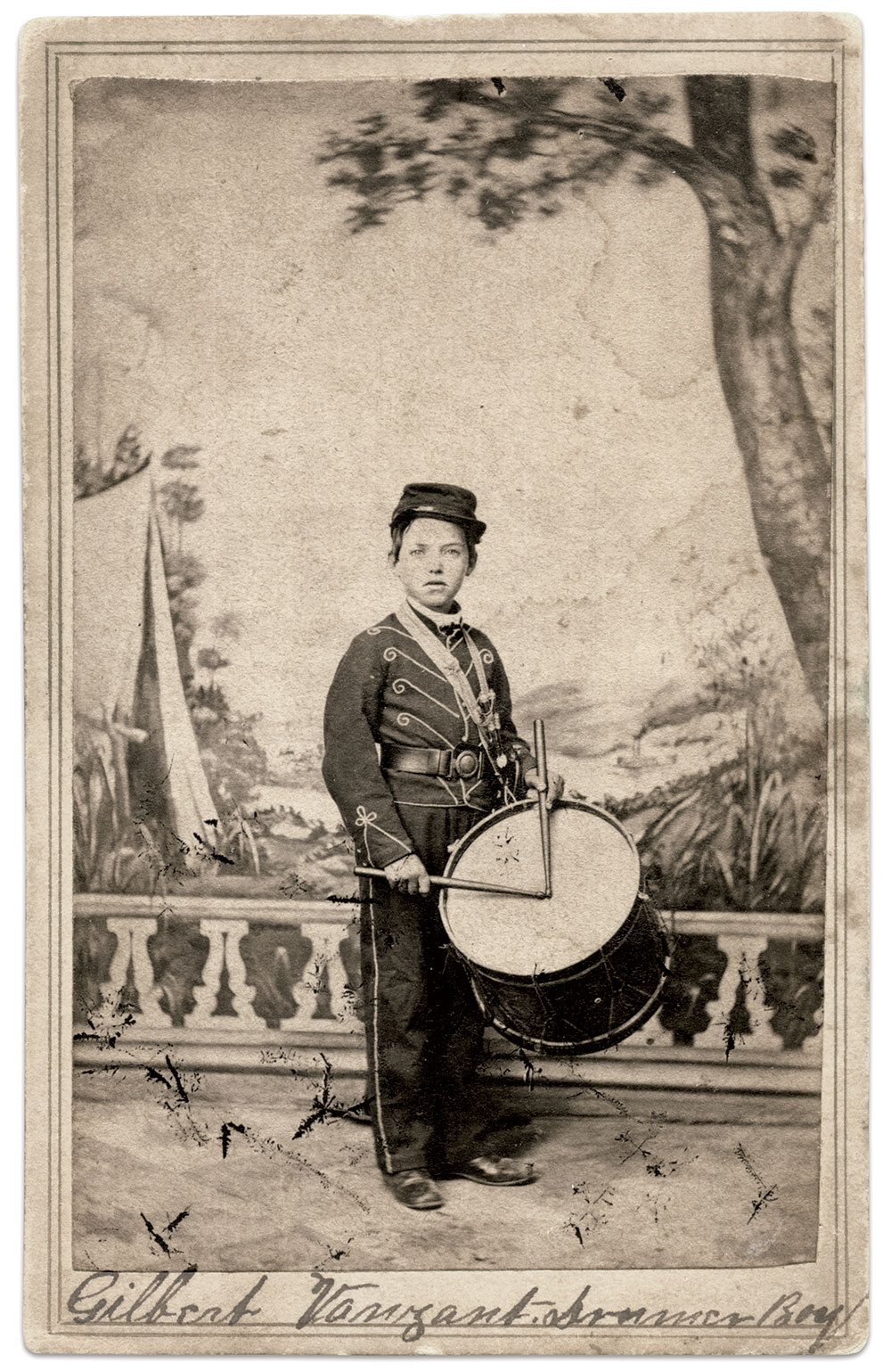
GILBERT VANZANT, the 10-year-old drummer known as “Lil Gib” to his comrades in the 79th Ohio Infantry, poses with his drum. An unruly child who had banged on tin pans with sticks as a toddler, his mother, Mary, imagined he’d be used only for recruiting, and figured after a dose of army life he’d soon be back home in Port William, Ohio. Her dreams were dashed when Gib took to soldiering and participated in the March to the Sea and other late war campaigns with Maj. Gen. William T. Sherman’s army. During the trek through Georgia, the diminutive Gib set aside his drum and became a dispatch carrier. According to a letter written by a captain, Gib “looked so small, so much like a child that I urged him to call one of the men. He informed me then and there that he could go anywhere a man could go. I gave him the message and late that night he brought me my receipt.”
Gib is pictured here in Nashville in late 1863 or early 1864. His distinctively trimmed uniform includes a tombeau on the cuff and curls on his taped front. An inscription on the back indicates this carte was owned by 1st Lt. Stephen Janney, who served with Gib in Company D.
Gib survived his time in uniform and reportedly refused the offer of a West Point commission by President Andrew Johnson, whom he met in Washington, D.C., after the end of hostilities. Gib lived until 1944, dying at age 92. A historical marker located in Port William honors his service.
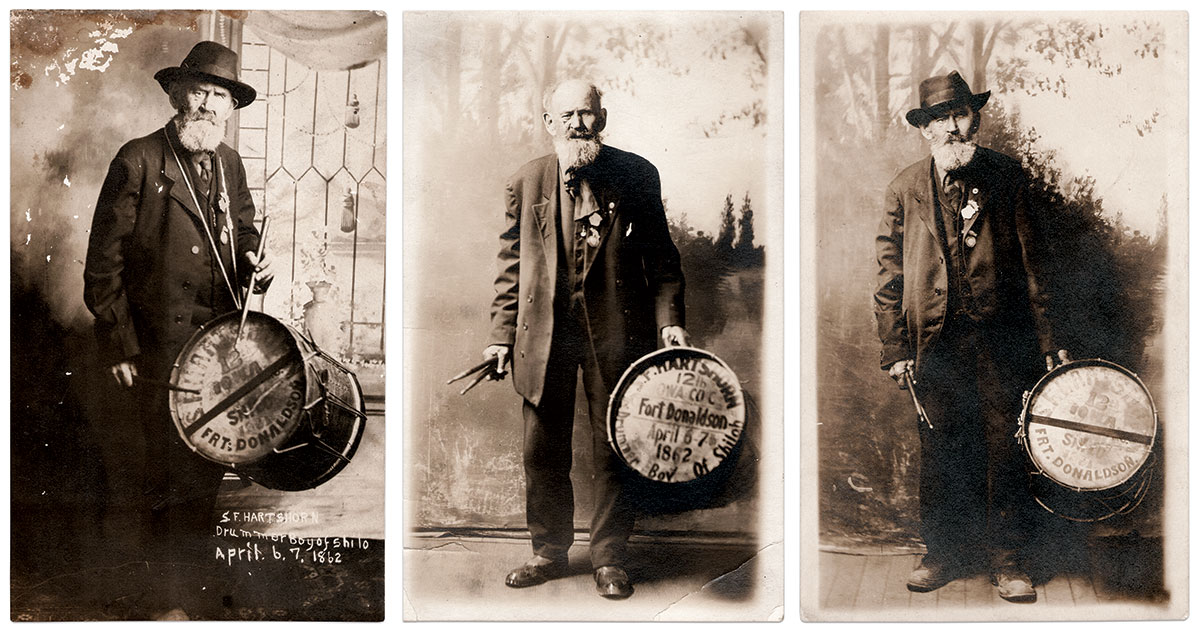
IOWA’S “DRUMMER BOY OF SHILOH” poses long after the battle with a post-war drum bearing his name and battles in which he participated. Sumner Flint Hartshorn joined Company C of the 12th Iowa Infantry in October 1861, and six months later found himself in the thick of the action at the Battle of Pittsburg Landing. According to one story of the fight, Hartshorn pulled his lieutenant from beneath a fallen horse and helped him to safety. About this time, Hartshorn suffered a wound that destroyed one eye, and impaired the other. He left the regiment with a disability discharge a few months later. Hartshorn married and settled in Dundee, Mich., where he and his drum became a regular at Grand Army of the Republic parades. He is pictured here towards the end of his life wearing G.A.R. medals. He died in 1919 at age 81. Five children survived him.
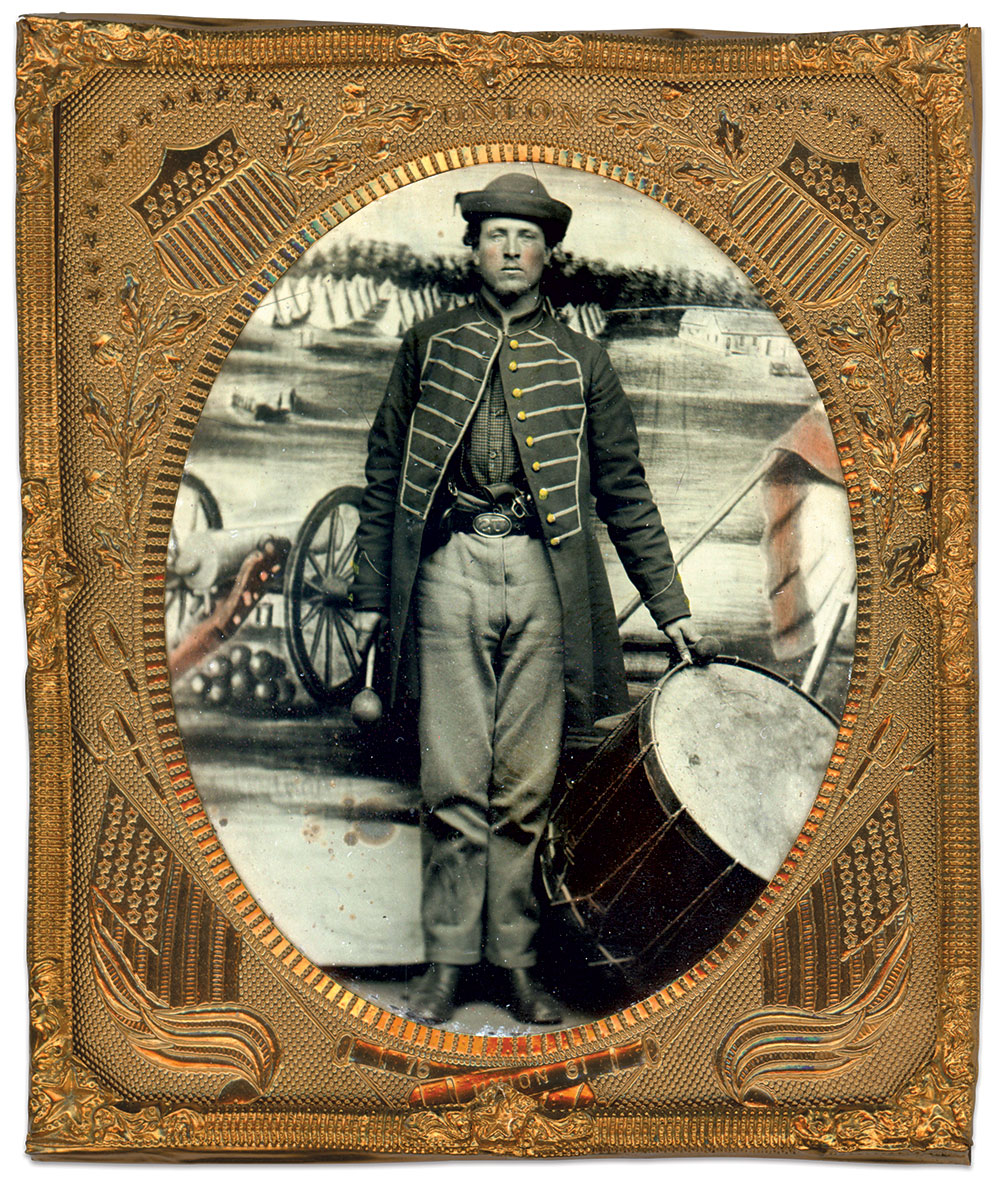
ARMED WITH A BASE DRUM AND MALLETS, this musician poses with his frock coat unbuttoned to reveal a revolver and knife tucked into his waist belt with an oval US plate. Note his civilian hat. He stands before an elaborately painted backdrop that features a field cannon and flag in the foreground, a river in the middle ground and, in the distance, a camp of Sibley tents and outbuildings.

BOLD BRUSHSTROKES OF COLOR embellish the stencil on the drum of this musician wearing a red-tinted sash sans waist belt. He wears a standard sling with adjustable leather front piece to hold the drum in place. A painted backdrop featuring the Stars and Stripes floats above a reinforced trench. The name “John Miller” written inside the case is a clue to his identity.
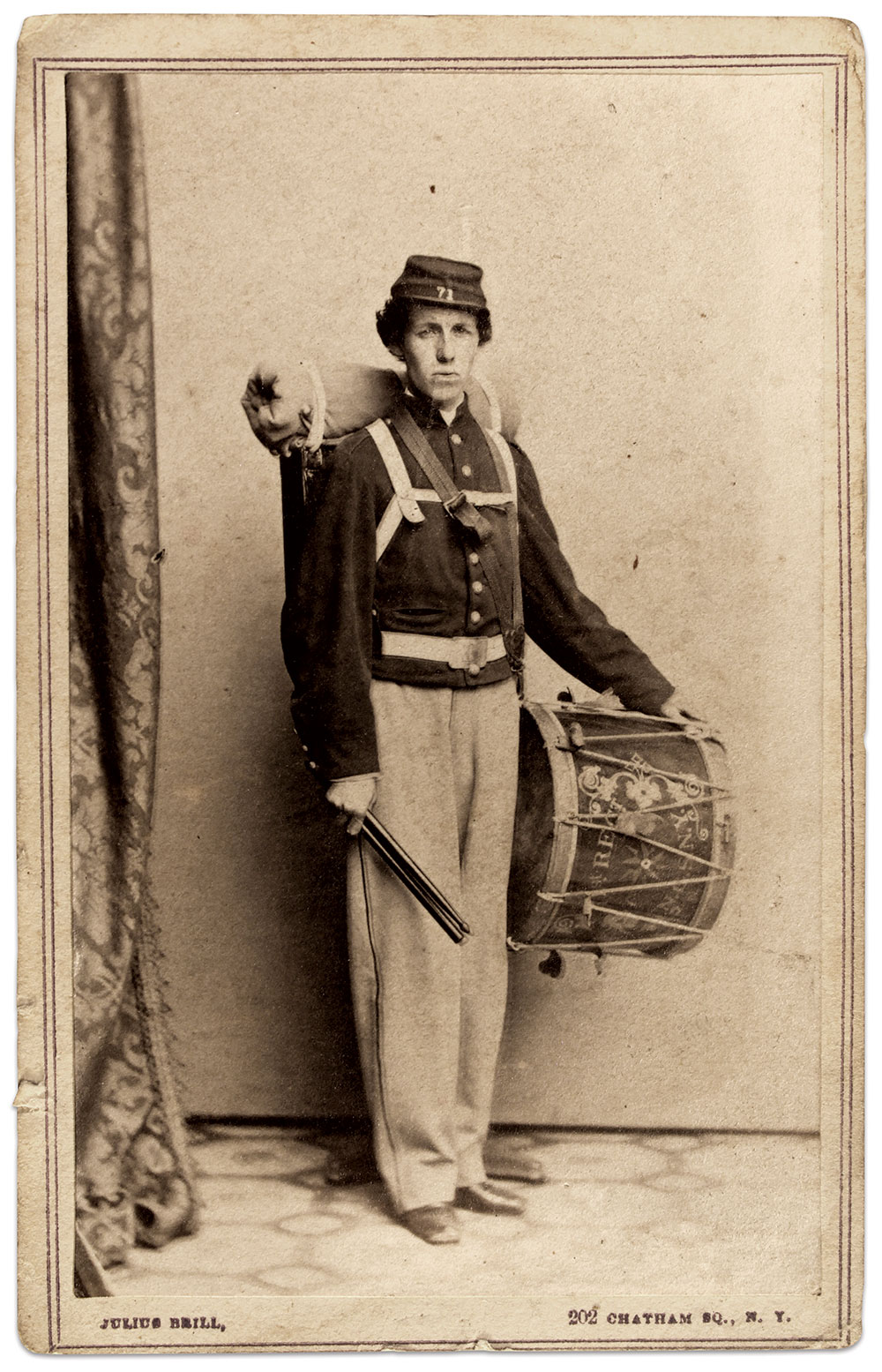
THE CUSTOM-PAINTED DRUM held by this musician and the number on his cap indicates he served in the 71st Regiment, New York State Militia, National Guard. His knapsack suggests that he is headed off to a deployment. The regiment activated for federal service three times during the Civil War: Three months in 1861, including the First Battle of Bull Run, three months in 1862 spent in the defenses of Washington; and one month in 1863 during the Gettysburg Campaign, during which it participated in skirmishes at Kingston and Oyster Point, Pa. A revenue stamp on the back of the mount is dated Aug. 19, 1865, two years after the regiment’s last federal service.
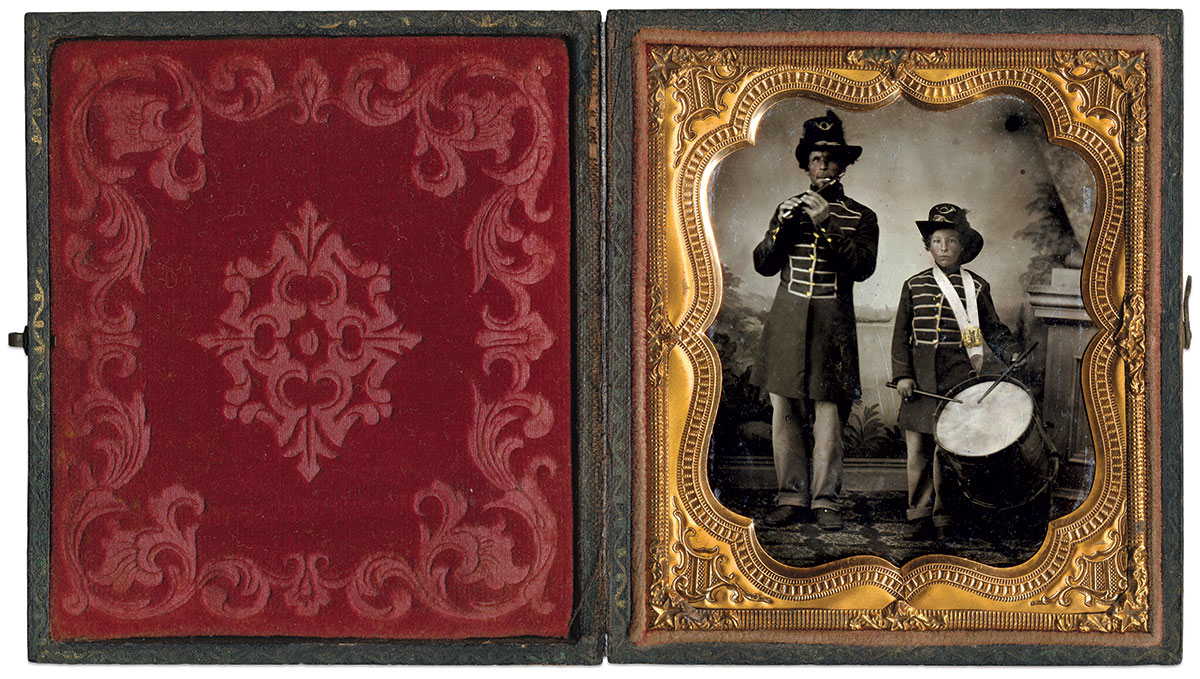
REGULATION FROM HEAD TO TOE, this drummer boy’s father might be the fifer standing beside him.
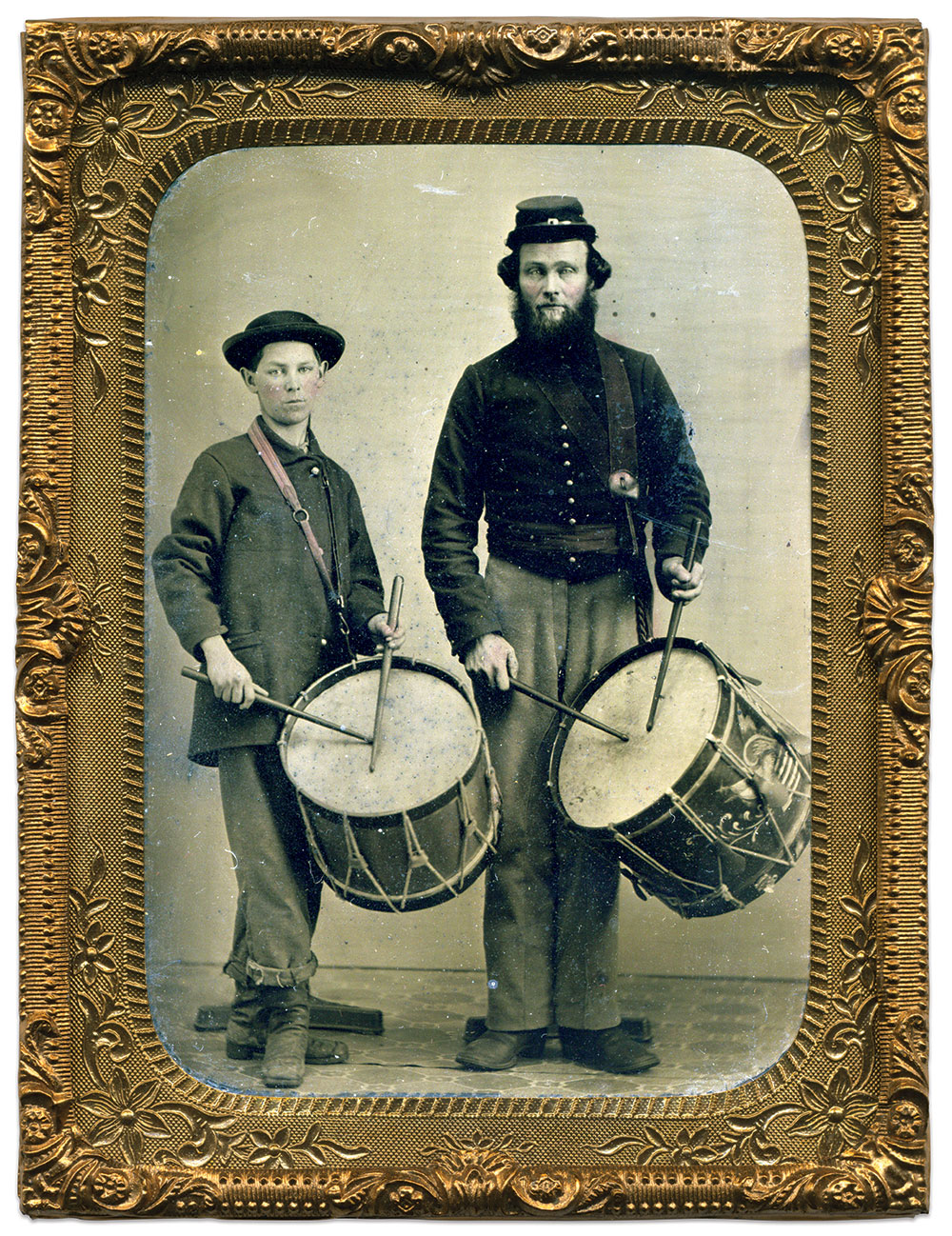
TWO REGULATION DRUMS, one plain and another stenciled with a patriotic Union motif, are shouldered by a clean-shaven youth and a bearded man. The boy wears a 4-button sack coat with an external pocket and a slouch hat and the man a short jacket and a Pattern 1858 cap. Note the neck slings—the one carried by the older man is standard and the boy’s is non-regulation.
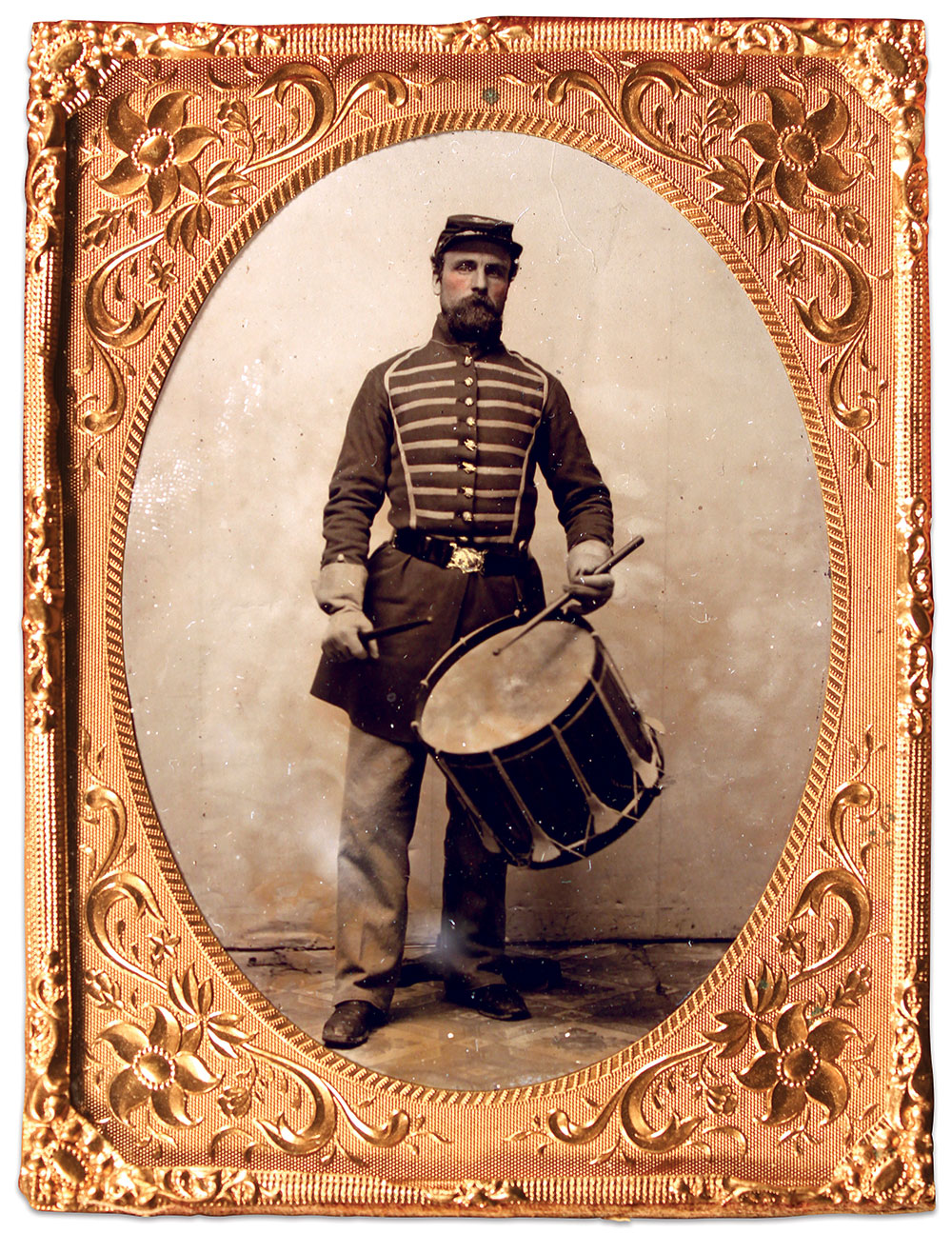
INSTEAD OF THE USUAL NECK OR SHOULDER SLING, this musician supports his drum with a leather loop and hook attached to his waist belt with militia buckle. Other less common details include gauntlets, single button cuff trim and light-colored tighteners, which are triangular shaped and uniformly positioned along the base of the drum.
LEARN MORE about Military Images, America’s only magazine dedicated to showcasing, interpreting and preserving Civil War portrait photography.
VISIT OUR STORE to subscribe, renew a subscription, and more.

